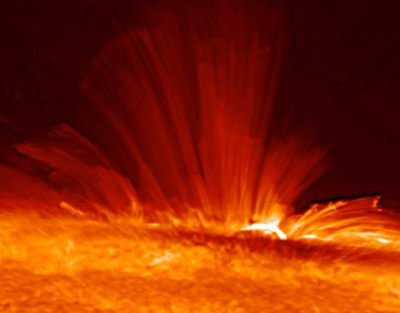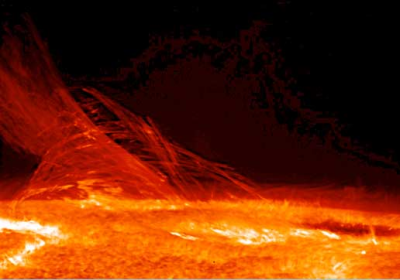30 March 2007

Credit: Hinode JAXA/NASA
On 21 March 2007, NASA published exquisite images of the Sun, relayed by the international spacecraft Hinode, a sophisticated space observatory. The unique images show fine structure in the solar magnetic field.
Hinode, Japanese for "sunrise" was launched 23 September 2006, to study the Sun's magnetic field and how its explosive energy propagates through the different layers of the solar atmosphere.
It is expected that Hinode's results would be as revolutionary to solar physics as the Hubble Space Telescope's impact on astronomy.

Credit: Hinode JAXA/NASA
"For the first time, we are now able to make out tiny granules of hot gas that rise and fall in the Sun's magnetized atmosphere," said Dick Fisher, Director of NASA's Heliophysics Division, Science Mission Directorate, Washington. "These images will open a new era of study on some of the Sun's processes that effect Earth, astronauts, orbiting satellites and the solar system."
Hinode carries three main instruments onboard to observe the Sun in visual light, X-rays, and ultraviolet. These devices will study the solar atmosphere from the Sun's visible surface, the photosphere, through the solar corona, the outer atmosphere of the Sun.

Credit: Hinode JAXA/NASA
"By coordinating the measurements of all three instruments, Hinode is showing how changes in the structure of the magnetic field and the release of magnetic energy in the low atmosphere spread outward through the corona, and into interplanetary space, to create space weather," said Project Scientist John Davis of NASA's Marshall Space Flight Center.
Space weather features the emission of energetic crepuscular and electromagnetic radiation. These eruptions of energy can disrupt global telecommunications and navigational systems.
"Hinode images are revealing irrefutable evidence for the presence of turbulence-driven processes that are bringing magnetic fields, on all scales, to the Sun's surface, resulting in an extremely dynamic chromosphere or gaseous envelope around the Sun," said Alan Title, a consulting professor of physics at Stanford University, Stanford, California.
Hinode is a collaborative mission led by the Japan Aerospace Exploration Agency (JAXA) and includes scientists from the European Space Agency, ESA, and Britain's Particle Physics Astronomy Research Council (PPARC).
The National Astronomical Observatory of Japan, Tokyo, developed the Solar Optical Telescope, which provided the fine-scale structure views of the Sun's lower atmosphere, and developed the X-ray Telescope in collaboration with the Smithsonian Astrophysical Observatory of Cambridge.
The X-ray Telescope captured the series of images of explosive events in the Sun's outer atmosphere.
"By following the evolution of the solar structures that outline the magnetic field before, during and after these explosive events, we hope to find clear evidence to establish that magnetic reconnection is the underlying cause for this explosive activity," said Leon Golub of the Smithsonian Astrophysical Observatory.
The Marshall Space Flight Center manages the development of the scientific instrumentation of the mission by NASA, industry and other federal agencies.
Further reading
www.nasa.gov/hinode
Aymen Mohamed Ibrahem